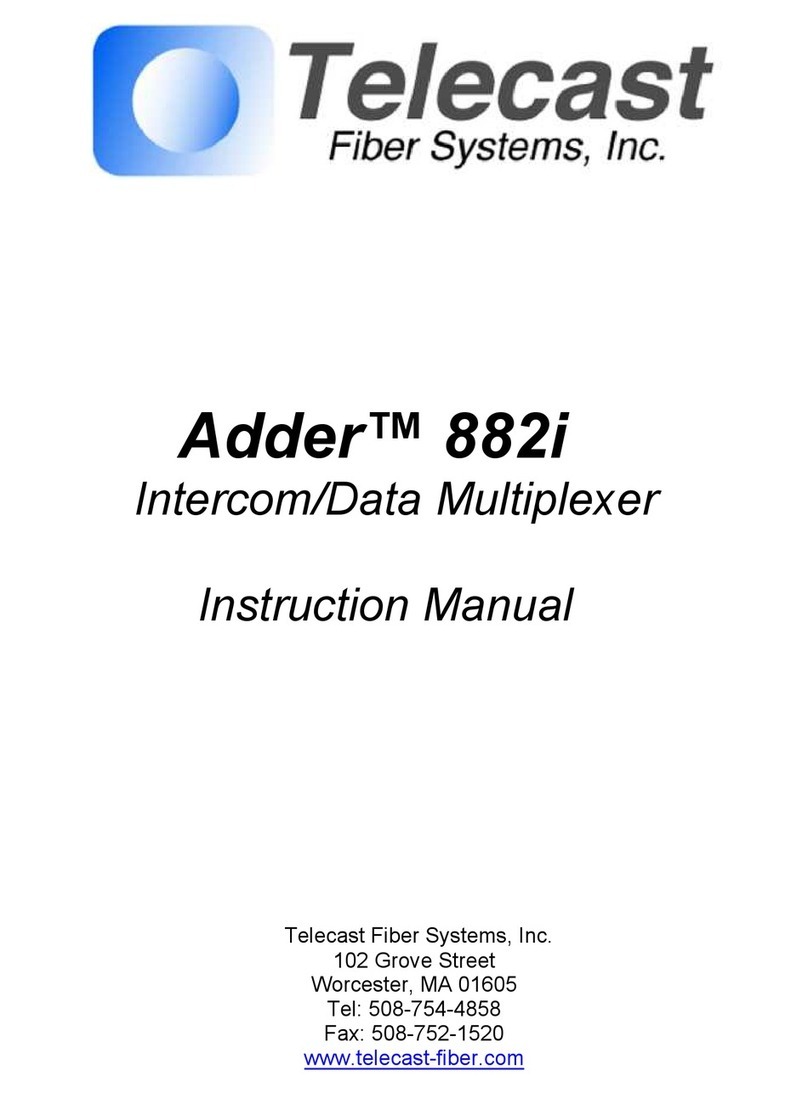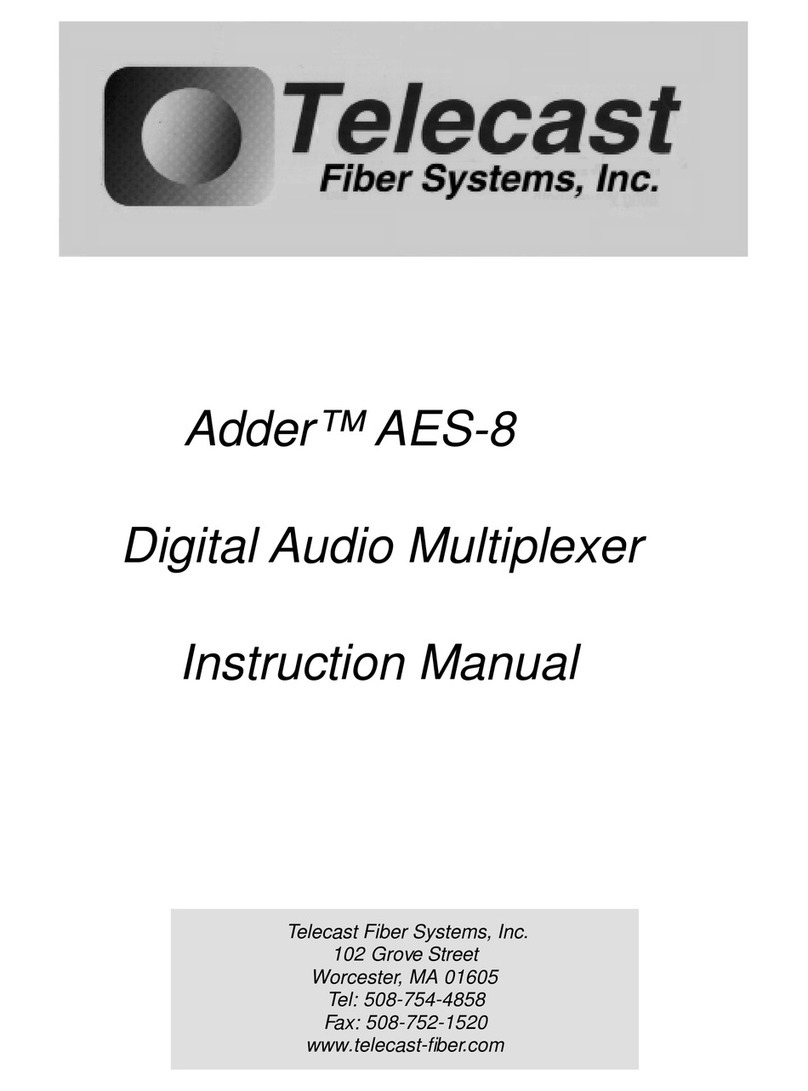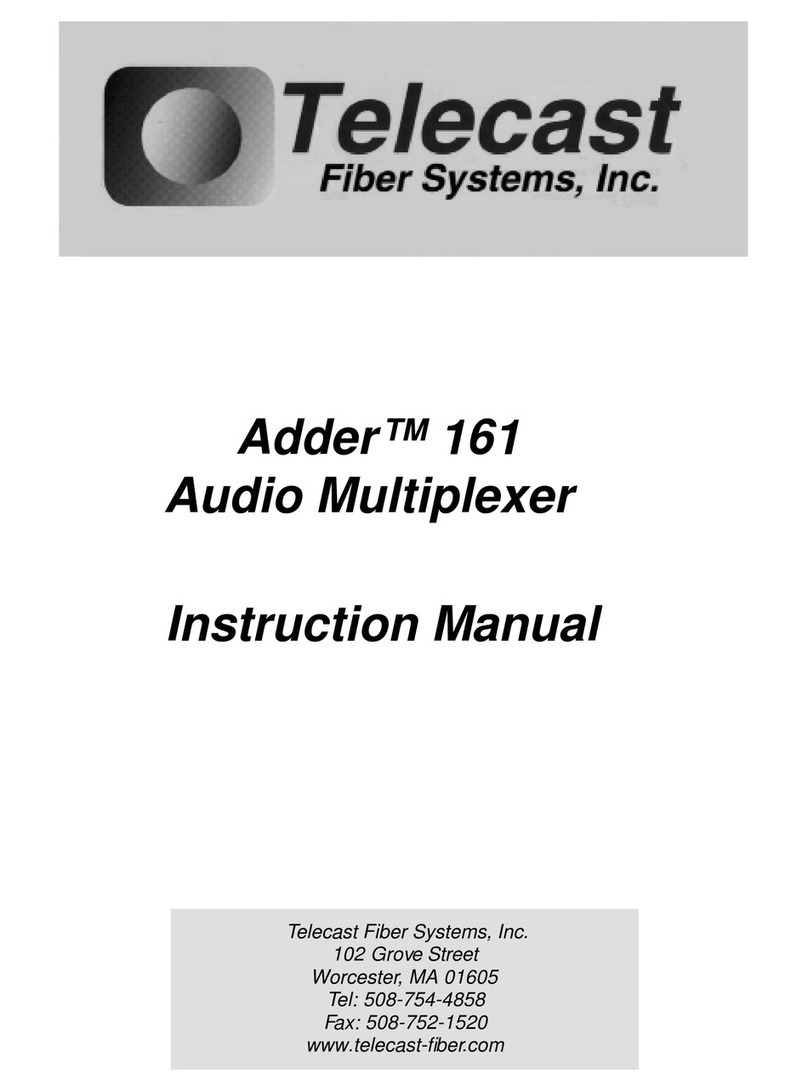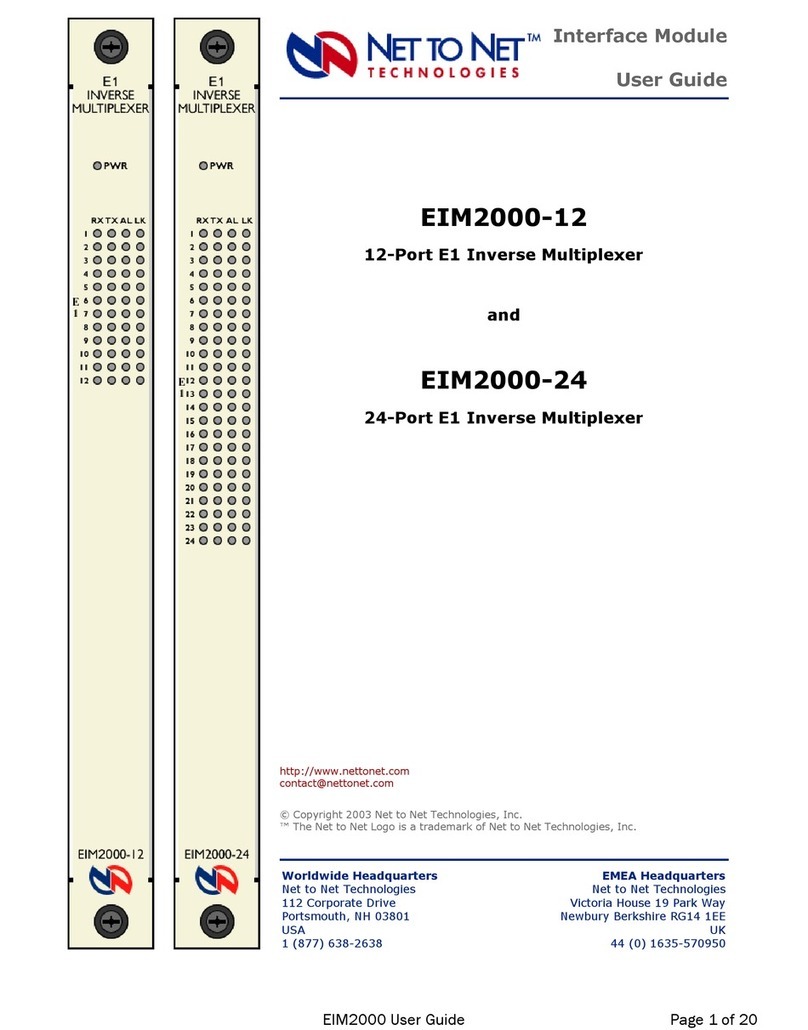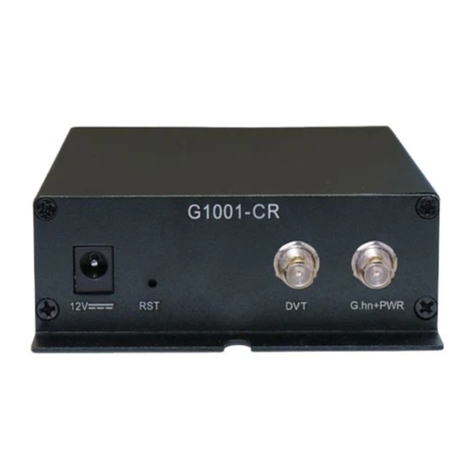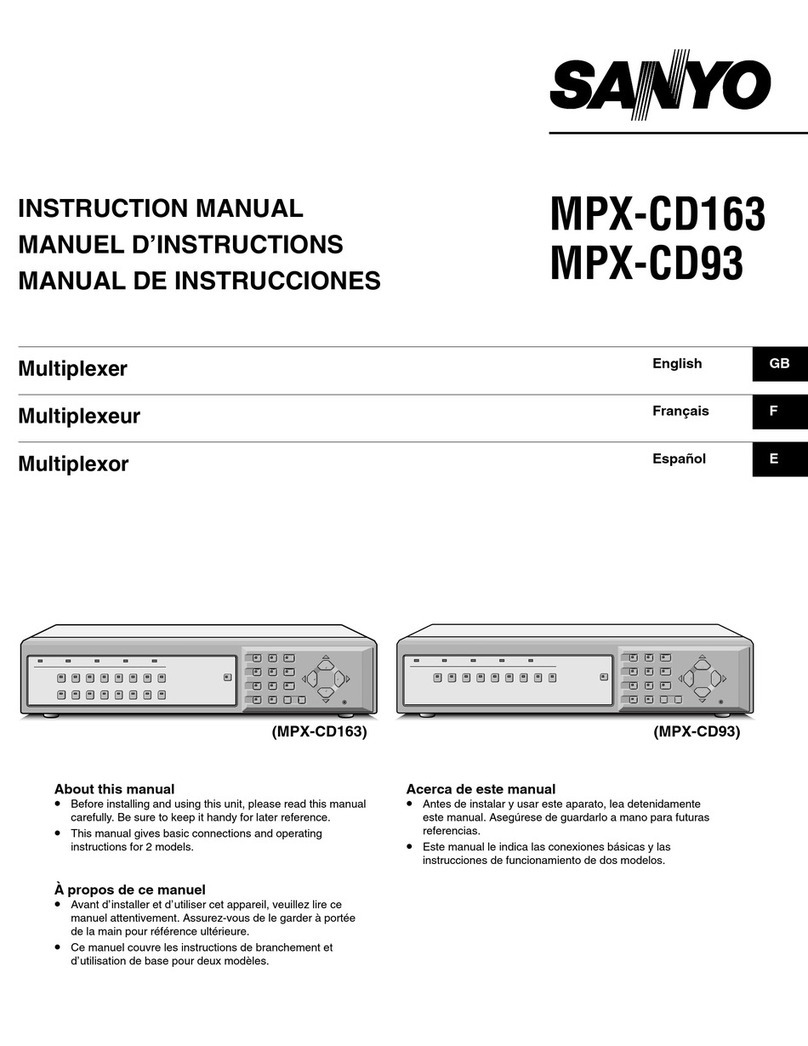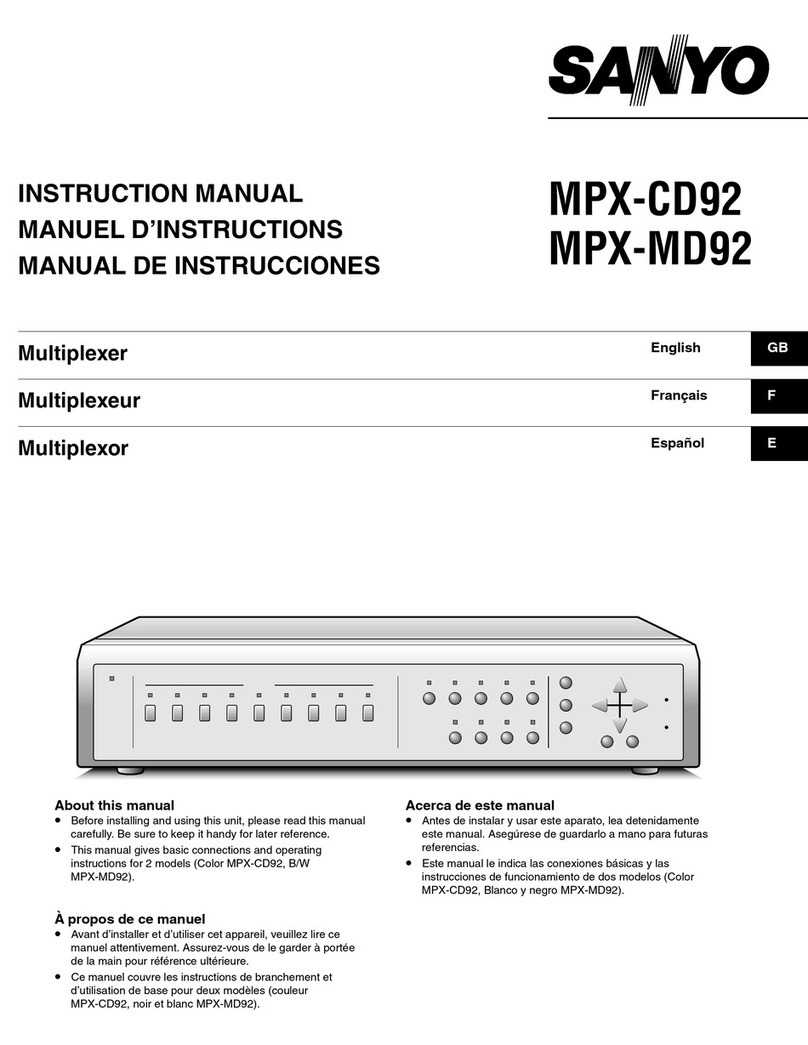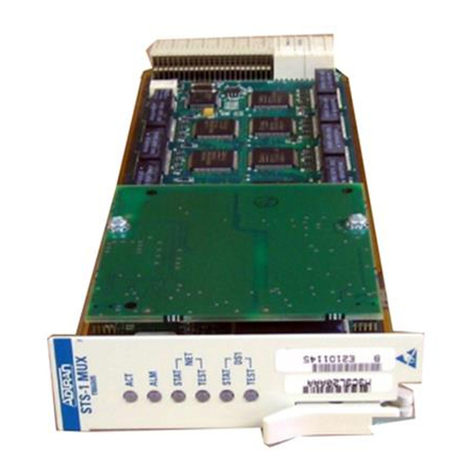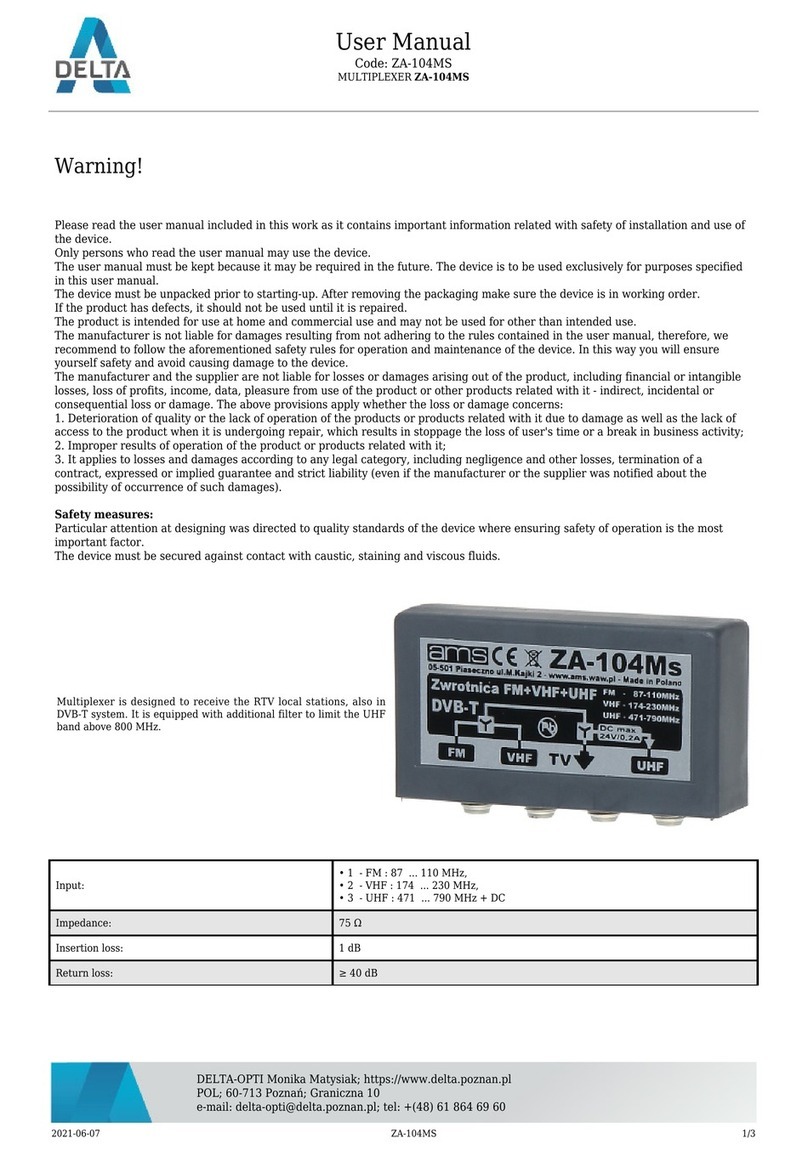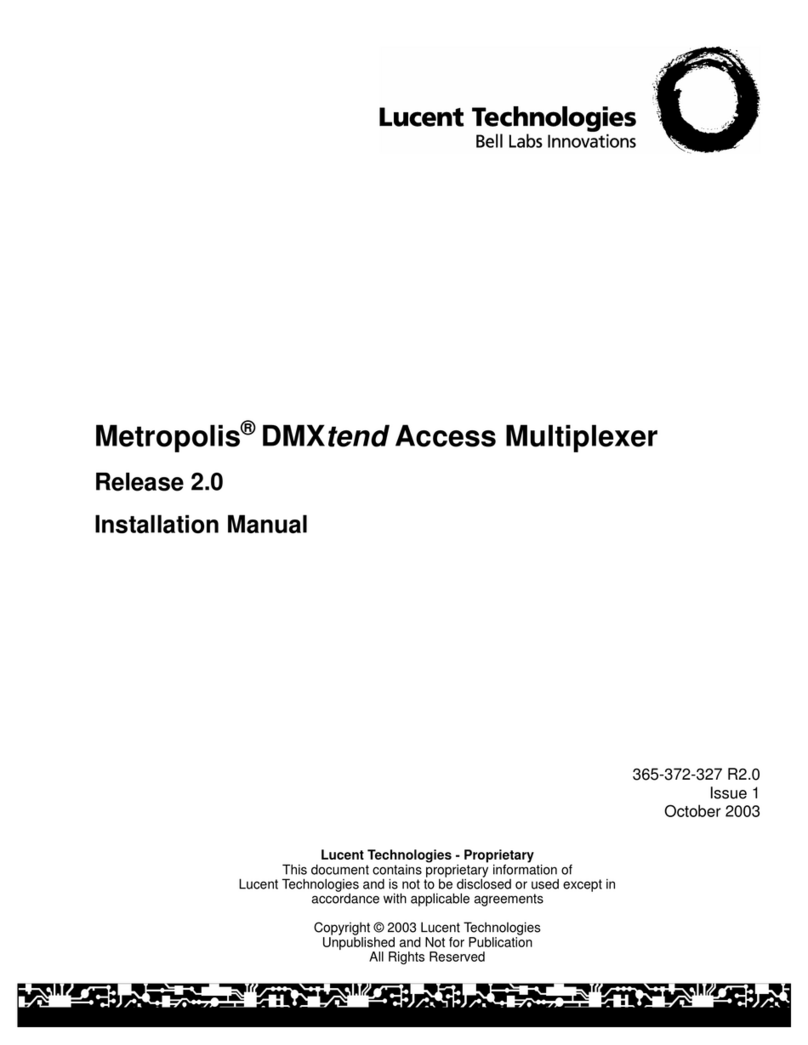Telecast Adder 162 User manual

Adder™ 162/322
Audio/Intercom/Data Multiplexer
User Manual
Telecast Fiber Systems, Inc.
102 Grove Street
Worcester, MA 01605
Tel: 508-754-4858
Fax: 508-752-1520
www.telecast-fiber.com

2

3
Table of Contents
Introduction 5
Overview 5
Coaxial Cable Input and Output 5
Status Indicators 5
Battery Backup 5
Audio Input and Output 5
Data Input and Output 5
Representative System 6
Options 6
Unpacking 6
Optical Fiber 7
Installation of the Assembly 7
Line Power 7
Line Power Connection 7
Input Power Fuse 7
DC Current Requirements 9
Battery Charging 9
Electrical Hookups 9
Audio Connections 9
Digital Connections 10
Optical Connections 11
Optical Fiber Signals 11
Cable Fabrication 11
Fiber Ports 11
Multiple Fiber Versions 12
WDM Single Fiber Versions 12
Coaxial Cable Ports 12
Cable Runs 12
Fiber 13
Input and Output Module Connections 13
Removing and Replacing Modules 15
Optical Fiber or Coax Communication Selection 16
Switch Settings (older rev only) 16
Coax Length (older rev only) 16
Audible Alarm Settings 17
Local Power Alarm 17
Remote Power Alarm 17

4
Audio Signal Setup 18
Input Module Setup 19
Gain 19
Impedance 19
Grounding 19
Auxiliary Items 21
Signal Generator/Monitor 21
Status Indicators 22
Power Supply 22
Status 22
Received Signal Level 23
System Interconnections 24
Powering Up 25
Intercom Modules 25
Intercom Connections 27
4-wire Auxiliary (balanced) 27
Clear-Com 28
RTS Telex 29
Intercom Module Replacement 30
Cable Harness 30
Intercom Setup Switches 30
Theory of Operation 32
Data Connectors 32
Audio Circuits 34
Preventive Maintenance 36
Accessory List 36
Troubleshooting 37
Measuring Optical Power 37
Specifications 38
Repair 40
Warranty 41

5
Introduction
Overview
The Telecast AdderTM 162 (32 channels) and Adder 322 (64 channels) are modular, multi-
channel communications systems designed for the transmission of high-quality audio, data and
intercom functions. The units pre-amplify, digitize, multiplex, transmit and receive up to 64
channels of audio information, four data channels and three dual-channel intercoms over one or
two optical fibers or 2 coaxial cables. Audio path evaluation is achieved using a built-in audio
signal (tone) generator and level meter/monitor.
Modules contain eight connectors for mic (high or low impedance) or line level inputs, or eight
output connectors for signals de-multiplexed from the send/receive fiber.
The Adder 162 accepts up to four modules in any combination for a total of 32 channels in a
6RU, 10 inch high x 19 inch wide electronic equipment rack. The Adder 322 accepts up to eight
modules for a total of 64 channels in a 10RU, 17.5 inch high x 19 inch wide electronic
equipment rack.
Coaxial Cable Input and Output
Each assembly has a coaxial input and output on which all signals are multiplexed. There is no
redundancy in the coaxial system. On older versions, the coaxial input is activated by internal
DIP switches on the Main PC Board. The coaxial output is always active. On newer models, the
dip switches are gone and the units work on coax priority. That is to say that the system looks
for the coax link first and then, if it does not see one, switches to optical.
Status Indicators
The front panel of the Adder 162/322 contains LED status indicators that monitor audio signals,
the DC power source, and the communication link status.
Battery Backup
A Ni-Cad emergency battery backup is built into the assembly. Battery backup is limited to
approximately 20 minutes and should be considered short-term power loss protection. The
available Telecast power module (ADAP-AC-03 or Eel) provides continuous battery charging
during line power operation.
Audio Input and Output
Audio input levels are set up for each channel by switches on the front of each input module.
These switches set input gain from 0 to 40 dB, input resistance to 600 Ohm or 10 kOhm and a
+48 VDC bias voltage to power microphones either ON or OFF. A ground lift switch is also on
the front panel for use with each channel.
Audio outputs are at line level. There are no operator controls on the output modules.
Data Input and Output
The Model 162/322 assembly accepts and multiplexes four digital data signals and two remote
relay closures onto the output fiber. The receiving assembly accepts the transmission, restores

6
the digital signals and provides the switch closures. The number of data channels is fixed and
independent of the number of audio channels in the assembly.
Representative System
The flexibility offered by 64 channels of audio and the capability of having both input and output
modules in a single assembly can lead to many efficient and innovative hookups. A
representative system using the Telecast 322 in a 3-way split is shown in Figure 1.
Figure 1: Adder 322 with a 3-way Split
Options
Configure the 162/322 system by selecting the following options. Contact Telecast for details.
AI820 8-channel Input Module
AO820 8-channel Output Module
4-wire Intercom
Clear-Com 2-wire Intercom
RTS/Telex dual-channel Intercom
Multi-mode WDM (Wavelength Division Multiplexer)
Single-mode WDM
Unpacking
The Adder 162/322 minimum configuration consists of one input and one or more output
modules. Input (Model AI820) and output (Model AO820) modules are installed and tested by
Telecast prior to shipment, in accordance with customer specifications. In addition, microphone
impedance and bias is preset per customer order, as is preamplifier gain for each channel. In
addition to the Model 162/322 assembly with its Input and Output Modules, a system also
includes:
External power supplies (AC/DC adapters)
Protective covers for optical connectors
Hardware kits for rack mounting the units

7
Optical fiber
After unpacking, inspect the units for mechanical damage, and electrical connectors for bent or
damaged pins. Report any damage to the carrier and to Telecast Fiber Systems, Inc.
Leave the protective caps on the optical connectors until it is time to attach the fiber to the units.
Replace the caps onto the connectors whenever the fiber is disconnected.
Installation of the Assembly
Units are shipped ready for rack use. Some Adder 162/322 connections can be made at the
front or rear panel, which would have been determined when the order was placed. For bench
use, remove the rack mounting flanges by unscrewing them at three places along each flange.
Line Power
The external power supplies provided with each assembly require 120 VAC. Be sure that AC
outlets are within reach of their 6-foot power cords. If your Adder is equipped with intercoms that
require power (RTS or Clear-Com), you will need two such power supplies per frame.
Line Power Connection
Insert the 4-pin XLR connector from the Telecast power supply into the INPUT POWER
Switchcraft D4M receptacle located at the upper left corner or rear of the 162, and located at the
lower right corner or rear of the 322. Plug the supply into a 120 VAC line. See Figure 2 and
Figure 3 for the power connector locations and Table 1 for electrical connections.
Fuse XLR
Power
Figure 2: Input DC XLR Power Connector and Fuse
Table 1: XLR Power Connections
PIN SIGNAL
1 Ground
2 & 3 Unused
4 + Input VDC
Input Power Fuse
The SLO BLO power fuse in Figure 2 and Figure 3 is located next to the INPUT POWER
connector. Use a 6.25 Amp 5 x 20 mm approved fuse type for both Model 162 and Model 322.
Be sure to use the same fuse type if replacement is required.

8
Figure 3: Adder 322 and 162 rear panels

9
DC Current Requirements
Any 15 VDC external power supply used with the Adder 162 must provide 2.5 amperes
continuous current.
Any 15 VDC external power supply used with the Adder 322 must provide 3.5 amperes
continuous current.
Although the Adder 162/322 assembly will operate at 10 VDC, ≥13.8 VDC is required to charge
the internal backup battery. System operation below 15 VDC can cause battery charge
depletion.
Battery Charging
The internal battery is automatically charged whenever 13.8 VDC is provided at the INPUT
POWER connector shown in Figure 2 on page 3. Full charge takes 16 hours, and will power
Model 162 for 30 minutes and Model 322 for 15 minutes.
Electrical Hookups
Audio Connections
Audio I/O is via 3-pin XLR connectors with industry standard wire locations. See Table 2 and
Figure 4.
Table 2: XLR Audio I/O Cable Connections
PIN SIGNAL
1 Ground
2 Balanced I/O (-)
3 Balanced I/O (+)
The XLR connectors are located on the front panel of each module. On the input modules, XLR
connectors are female Neutrik type NC3FPR-H. On the output modules, XLR connectors are
male Neutrik type NC3MG-H. Refer to Figure 4.
INPUT (Female) OUTPUT (Male)
1221
3
Figure 4: XLR Connectors on Input and Output Modules
3

10
Digital Connections
The Model 162/322 assembly accepts and multiplexes four RS-232C or RS-422 digital data
signals and two remote relay closures. The 162/322 is also used to receive a transmission,
restore the digital signals and provide switch closures. The number of data channels is fixed and
independent of the number of audio channels in the assembly. Both data input and output are
accomplished on the same connector.
Digital signal connections are made via 9-pin D connectors; see Figure 5. The connection
specifications are listed in Table 3. A 110 Ohm terminating resistor placed across the balanced
inputs may be needed if input cable lengths are in excess of 6 feet. Serial communications can
be RS-232 at one end and RS-422 at the other, if desired.
Contact closure input is activated by pin 8 on contact to ground or to a TTL logic 0 signal level.
Contact closure output is established by an isolated, normally open, dry contact built onto the
Main PC Board.
51
69
12 34
DATA I/O
Figure 5: 9-pin D-connectors
Table 3: Digital Cable Connections
PIN Connectors 1 & 2 Connectors 3 & 4
1 RS-422 in (-) RS-422 in (-)
2 Contact out No Connection
3 Ground Ground
4 RS-232 out RS-232 out
5 RS-422 out (-) RS-422 out (-)
6 RS232/422 in (+) RS232/422 in (+)
7 Contact out No Connection
8 Contact in No Connection
9 RS-422 out (+) RS-422 out (+)
The four digital I/O connectors are AMP 747905-2, D subminiature female or equivalent.

11
Optical Connections
WARNING: Never look directly into the end of the optical fiber until it has been positively
determined to be safe. Eye damage could result.
Optical Fiber Signals
Each 162/322 system has multiple optical connections. As a minimum, a transmit output must
be connected via a suitable fiber to a receive input.
Fiber transmissions can be 100% redundant. A secondary fiber output operates with
independent drivers and is always active. If the active fiber link fails, an alarm is sounded and
the secondary link takes over.
Two additional, fiber outputs are available for local splits. This is useful when the same outputs
are received at multiple locations.
The Adder 162/322 is compatible with industry standard ST type connectors. It may be used
with installed backbone cables or with dedicated cables. Consult Telecast for information
regarding compatible fiber types.
Cable Fabrication
Assembled cables and connectors are available from Telecast Fiber Systems, Inc. For custom
cable fabrication, use type ST connectors such as Telecast part number CONN-ST-M.
Always follow the connector manufacturer’s directions when fastening a connector to the cable.
A Quick-crimp kit, part number CKIT-3M, is available from Telecast.
Always cover all unused fiber connectors.
Transmission Fiber Ports - Multiple Fiber Versions
TX1, TX2, TX3 and TX4
Fiber ports Tx1, Tx2, Tx3 and Tx4 shown in Figure 6 are fully redundant. All transmit ports are
always active and have independent output circuits.
Rx1 Rx2
Tx1 Tx2
Rx Tx
Tx4Tx3
FIBER
(Rx 1550) (Rx 1300)
(Tx 1300) (Tx 1550)
W
D
M
Coax
Figure 6: Fiber and Cable Ports

12
All ports carry digitized, multiplexed audio as well as digital and contact data. Each output has
the same capacity with distance capabilities as shown in Table 4. Unless otherwise specified, all
transmitters operate at 1300 nm except Tx2 which operates at 1550 nm.
Rx1 and Rx2
Fiber ports Rx1 and Rx2 accept the multiplexed optical signals from the output of another Model
162/322. The received signal is demuxed and sent to the output corresponding to the original
input on the transmitting assembly. These fiber input ports are internally switched with
preference to Rx1. If the active port fails to recognize a signal, the assembly switches to the
alternate port and an alarm sounds. An alarm also sounds if neither port has a signal present.
WDM Single Fiber Versions
The Rx ports in Figure 6 on page 7 are used to send and receive optical signals over a single
fiber on assemblies with Telecast’s Wavelength Division Multiplexer option (WDM). This is
accomplished by transmitting on one wavelength and receiving from the same fiber on an
alternate wavelength.
Since each unit is identical, Rx1 must be connected to Rx2 on the second unit to complete the
optical circuit. A redundant circuit from Rx2 on the first unit and Rx1 on the second unit can be
added using a second fiber.
The Tx1 and Tx2 ports are combined with the Rx1 and Rx2 ports by the WDM. Tx3 and Tx4
remain active and are still available for local splits.
Coaxial Cable Ports
Coaxial ports Rx and Tx carry the same data as the optical ports. The coax output is always
active. On older Adders, the coax input is active only when the optical receive inputs have been
disabled via SW1. Coax operation cannot be used as redundancy for the optical circuit.
Fiber Cable Runs
The installer is responsible for providing the fiber optic cable runs, available from Telecast Fiber
Systems, Inc. The Accessory List on page 31 shows cable and other items required for the
system. Be sure that the fiber types are compatible with the intended installation distances, as
shown in Table 4.
Table 4: Distance Limits by Fiber Type
Fiber Type Distance Limit
50/62.5/125 multimode 10 km
8/125 singlemode 20 km
All outputs and inputs of the standard unit are multimode (mm) and single mode (sm)
compatible. Tx2 is 1550 nm and all other transmissions are 1300 nm. When the WDM option is
ordered, the use of sm or mm must be specified.
If the WDM is installed, the fiber used must match that of the WDM to assure functionality.

13
Inspect and clean the fiber ends with clean, dry compressed air or with Kim-Wipes and isopropyl
alcohol. Fingerprints, or other dirt on the optical connector end surfaces, will reduce the
received optical signal level.
Coax
To use the system with coax instead of optical fiber, use Belden 8281, 75 Ohm or equivalent.
Refer to Optical Fiber or Coax Communication Selection on page 16 for the switch settings on
the Main PC Board which govern coaxial use with older Adder 162/322.
Input and Output Module Connections
Figure 7 shows an Input Module and an Output Module. The left ribbon on each module is the
signal conductor; the right ribbon provides power. Each ribbon plugs into a specific spot on the
Main PC Board; refer to Figure 8a on page 10.
Signal Power
Figure 7: Input (upper) and Output (lower) Modules for Adder Model 162/322
Module mounting slots are numbered from the upper part of the chassis to the lower part: A to D
on Model 162, and A to H on Model 322. The Model 162/322 Main PC Board has two sets of
signal and power ribbon connector terminations. See Figure 8.
Signal Ribbons (left side of main board) J11 to J8 are for signal ribbons A to D on Model
162/322. J7 to J4 are for signal ribbons E to H on Model 322.
Power Ribbons (right side of main board and auxiliary board) J24 to J21 are for power ribbons
A to D on Model 162/322. Power for modules E to H on Model 322 is supplied from an
additional power supply board located below the Main PC Board. See Figure 9 on page 14.
Other than module count, number of multiplexed signals, and size, the Models 162 and 322 are
identical in all respects.

14
Figure 8: Model 162 Main PC Board
Figure 9: Model 322 Auxiliary Power PC Board
ALARMS
ICOM
GAINS
DATA POWER
More Module
Power on 322’s

15
Removing and Replacing Modules
Figure 10 shows a Model 162 assembly and Figure 10 shows a Model 322 assembly.
Figure 10: Adder 162 and 322 - Modules
To change the configuration of your Adder 162/322 assembly:
1. Switch the power to the assembly OFF.
2. Loosen the two mounting screws at the left and right of the module.
3. Unplug the ribbon connectors at either end of the modules. Note that the connections
have spring locks that must be squeezed to be removed.
4. Change the module, and plug the respective signal and power connectors back into
their ports on the module. Tighten the mounting screws.
WARNING: Be sure to maintain the module location number from top to bottom in terms of
module location and connector position on the Main PC Board. An output module at
a given position must correspond to an input module at the same position at the
other end.
Pins on the ribbon connectors are very small in order to best use the very limited amount of
space in the Adder. Be careful not to bend pins when mating ribbon cables to their connectors.

16
Optical Fiber or Coax Communication Selection
Switch Settings
Switches on the Main PC Board control connectors between Adders over either fiber or coax.
Locate SW1 in the lower left corner of the Main PC Board (Figure 8a on page 10).
To receive from optical fiber, configure SW1 according to Figure 11.
Figure 11: Optical Fiber Receive Switch Setting
To receive from coax, configure SW1 according to Figure 12.
Figure 12: Coax Receive Switch Setting
Coax Length
Configure SW2 according to the length of coaxial cable being used. Refer to Figure 13.
Figure 13: Coax distance Settings
The maximum length of coaxial cable that can be used on any single run between assemblies is
1000 feet.
On newer versions, these switches do not exist and the units function in “Coax priority”. This
means that the systems first looks for a coaxial link. If one is not found, the system automatically
begins looking for an optical link. In addition, SW2 is also gone and coax lengths are handled by
an automatic coaxial length equalization circuit.

17
Audible Alarm Settings
An audible alarm is provided to indicate error conditions. This alarm can be deactivated by the
front panel ALARM ON/OFF-RESET switch. Refer to Figure 19 on page 22. In addition, the
REMOTE POWER and LOCAL POWER alarms can be disabled internally by SW6. Locate
SW6 in the upper right corner of the Main PC Board (Figure 8a on page 14).
Local Power Alarm
The LOCAL POWER ALARM indicates a failure in the external power input at this unit. To
configure the alarm for local power, configure SW6 according to Figure 14.
Figure 14: Alarm Switch — Local
Remote Power Alarm
The REMOTE POWER ALARM indicates a failure in the external power input at the remote unit
(i.e., the unit transmitting to this unit). To configure the alarm for remote power, configure SW6
according to Figure 15.
Figure 15: Alarm Switch — Remote
Alarms are latching. If an alarm occurs, the Audible alarm will sound until the front panel alarm
switch is set momentarily to OFF.

18
Audio Signal Setup
The switches for line or mic input levels, gain, and ground are positioned below the audio
connectors on the front panel of each input module. There are eight sets of switches, one set for
each channel. Channels are numbered left to right from 1 to 8. The panel switch markings for
channels 4 and 5 are shown in Figure 16.
The Model 162/322 system uses high frequency pre-emphasis on all audio channels. Maximum
level at 1 kHz with all gain switches off (unity gain) is +18 dBm. Maximum level at 20 kHz is
10dB lower, or +8 dBm.
The green LED indicates that a signal 30 dB below maximum, or -12 dBm or greater is present
at the channel input. The red LED indicates clipping, indicating that the A/D converter for the
channel is at or near overload and input gain or level must be reduced.
Figure 16: Input Audio Channel Switch Markings
Each channel setting should be carefully checked.
Output module gain is fixed. Maximum module output is +18 dBm, at 1 kHz, corresponding to
A/D clipping.
The LOz /HIz /48V INPUT switch (Figure 16) coupled with the input gain switches result in the
input signal levels shown in Table 5.
Table 5: Input signal levels
LOz, 600 Ohm balanced HIz, 10 kOhm balanced
Unity gain +18 dBm peak Unity gain +18 dBm peak
+10 dB +8 dBm peak +10 dB +6 dBV peak
+20 dB -2 dBm peak +20 dB -4 dBV peak
+30 dB -12 dBm peak +30 dB -14 dBV peak
+40 dB -22 dBm peak +40 dB -24 dBV peak

19
Input Module Setup
Use Table 6 to assist in setting up the front panel switches on each input module. You will be
setting up:
1. Input Gain: 0, +10, +20, + 30, and +40 dB
2. Input Impedance/Bias Voltage: LOz (600 Ohm), Hiz (10 kOhm) or 48V(at 10 kOhm)
3. Input Ground LIFT or GND
4. Gain
Determine the appropriate input gain for each channel and enter the value in Table 6. Refer to
Figure 17 for the front panel switch settings.
Note: Only one switch should be ON at a time as gain settings are NOT additive.
Table 6: Basic gain settings
Impedance
Determine the need for each channel’s input impedance at 600 Ohm or Hiz. Most systems
operate better in the Hiz mode.
If 48 V phantom power is needed, set the LOz/HIz/48 V switch to 48 V. With 48 V ON, the
impedance is always HIz. The phantom supply is limited to a maximum combined load of 60 mA
per 32 channels, which is about 2 mA per input channel with all channels in use. Source
impedance is 5000 Ohms. When fewer than the 32 loads are used, the current at each input
can be increased, limited by the 5000 ohm source resistance, up to a total of 60 mA for all
active loads. Always set unused phantom power switches to LOz or Hiz to be sure 48 VDC is
not applied where it is not needed.
Grounding - Determine the switch setting for Pin 1
When using 48 V phantom power, the PIN 1 switch on the front panel (Figure 16 on page 18)
must be set to GND. Do not set this to LIFT unless required to eliminate ground loops.
If phantom power is not being used, set this switch to the requirements of the channel’s signal
source. Make the appropriate entries in Table 6.
Double check your table and position each switch.
After your system is fully set up and operating, use the built-in signal generator to check for
adequacy of signal levels or for possible amplitude overload in any part of the audio path.

20
Table 7: Input Module Switch Settings
This manual suits for next models
1
Table of contents
Other Telecast Multiplexer manuals
Popular Multiplexer manuals by other brands
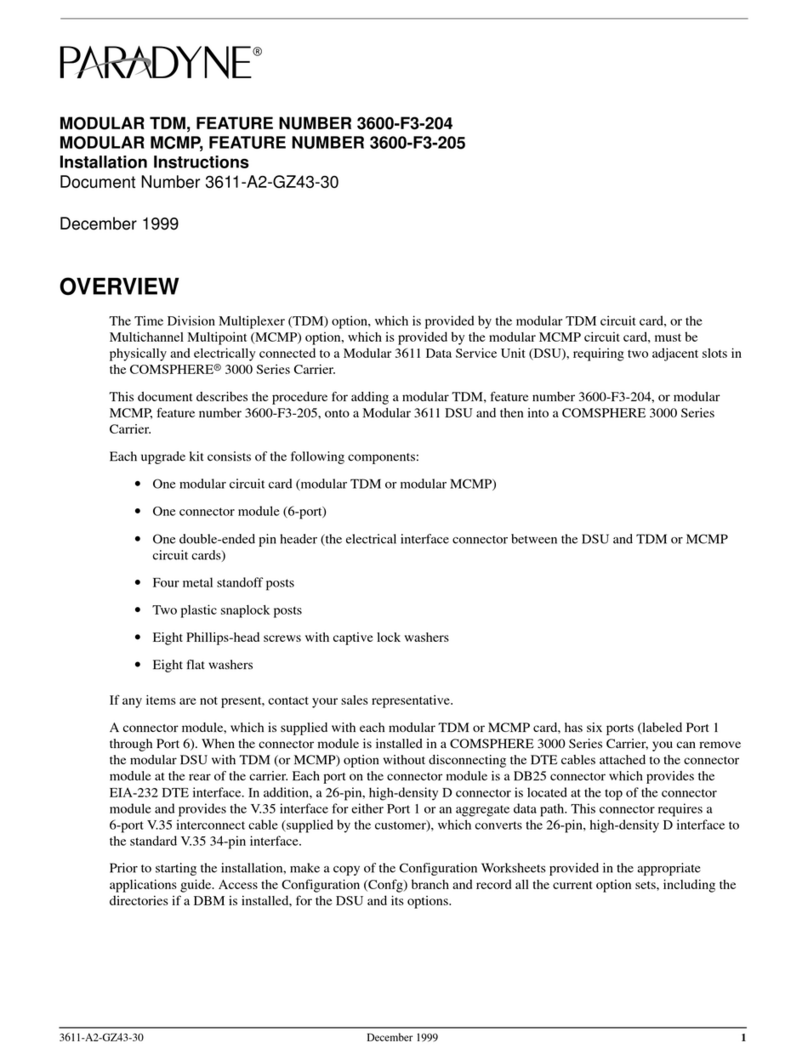
Paradyne
Paradyne COMSPHERE 3611 installation instructions
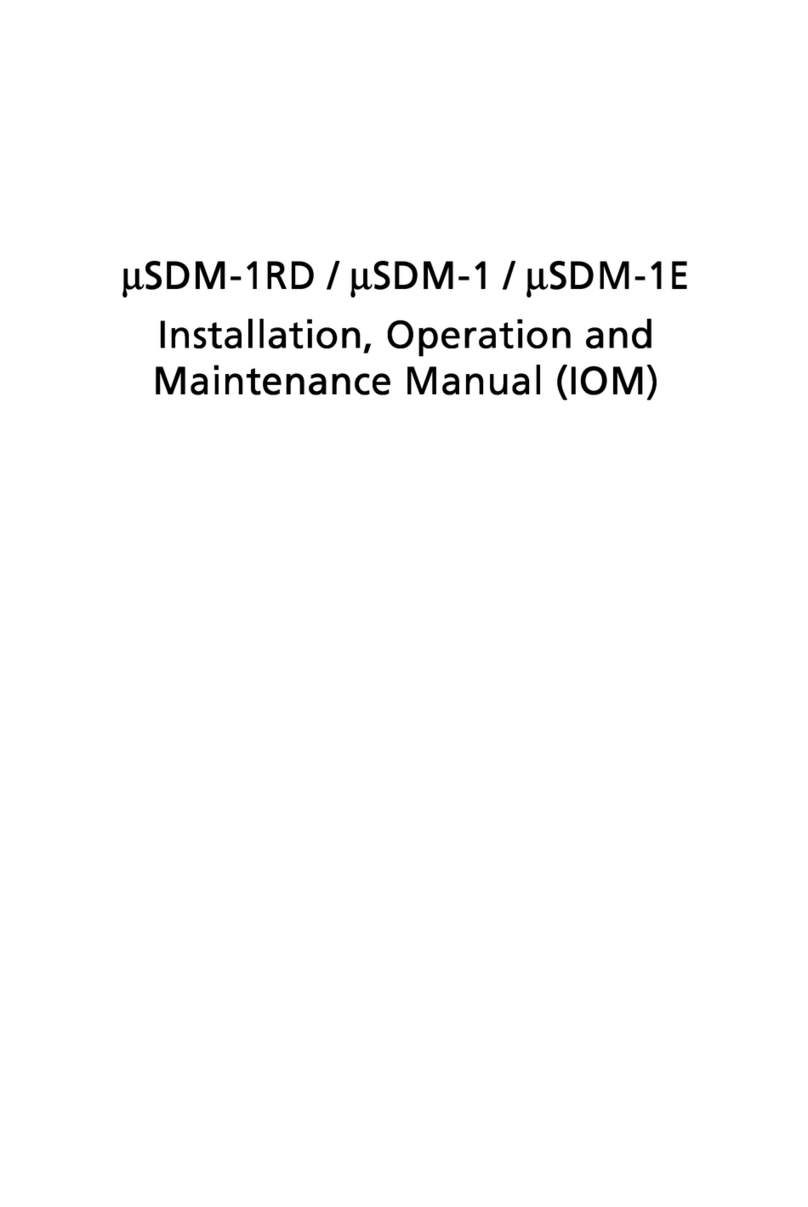
Lightscape Networks
Lightscape Networks mSDM-1RD Installation, operation and maintenance manual

Tunstall
Tunstall Flamenco 77 0270 00 installation instructions

Ross
Ross MUX-8258 Series user guide
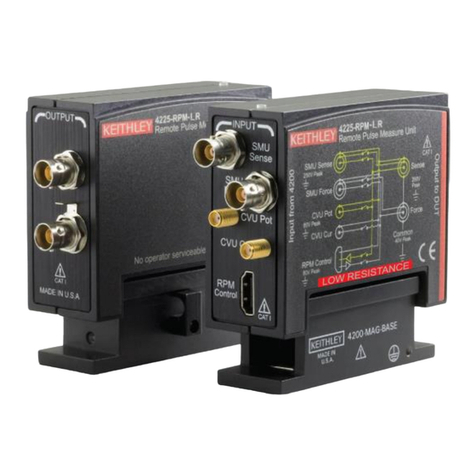
Keithley
Keithley 4225-RPM instructions
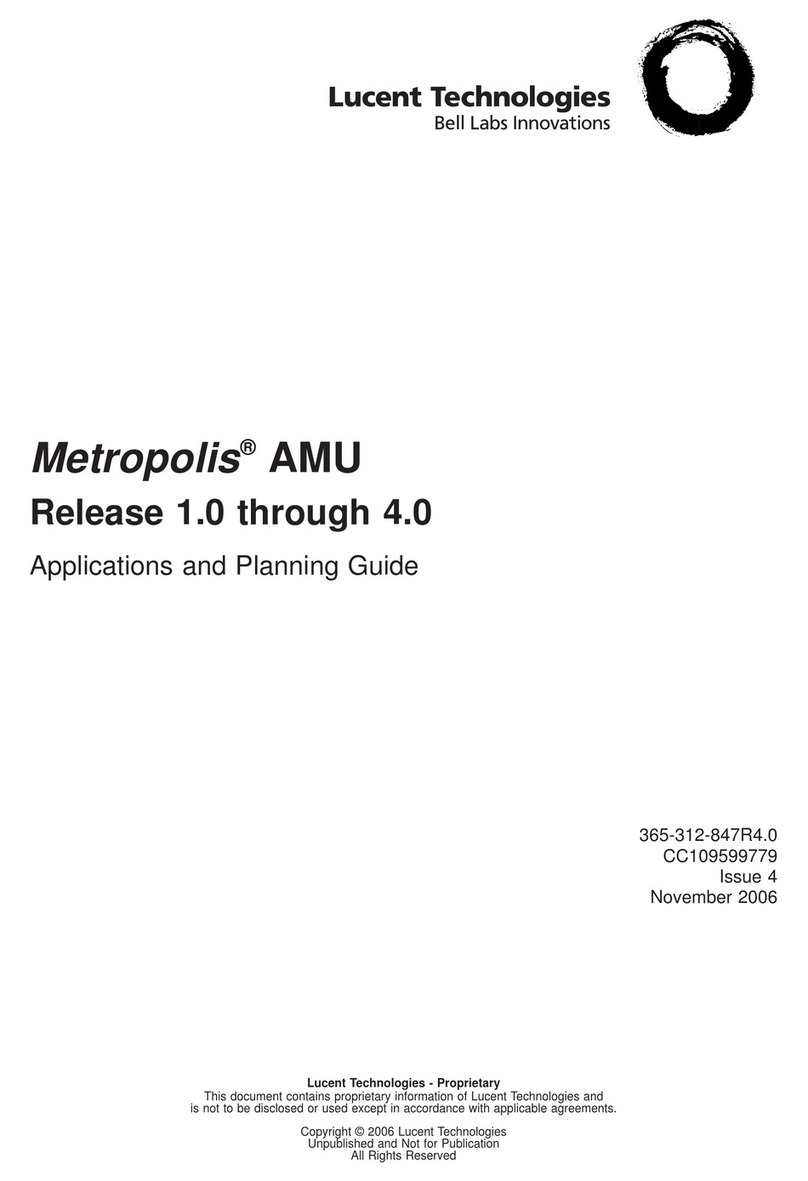
Lucent Technologies
Lucent Technologies Metropolis AMU 2m/4o Applications and Planning Guide

